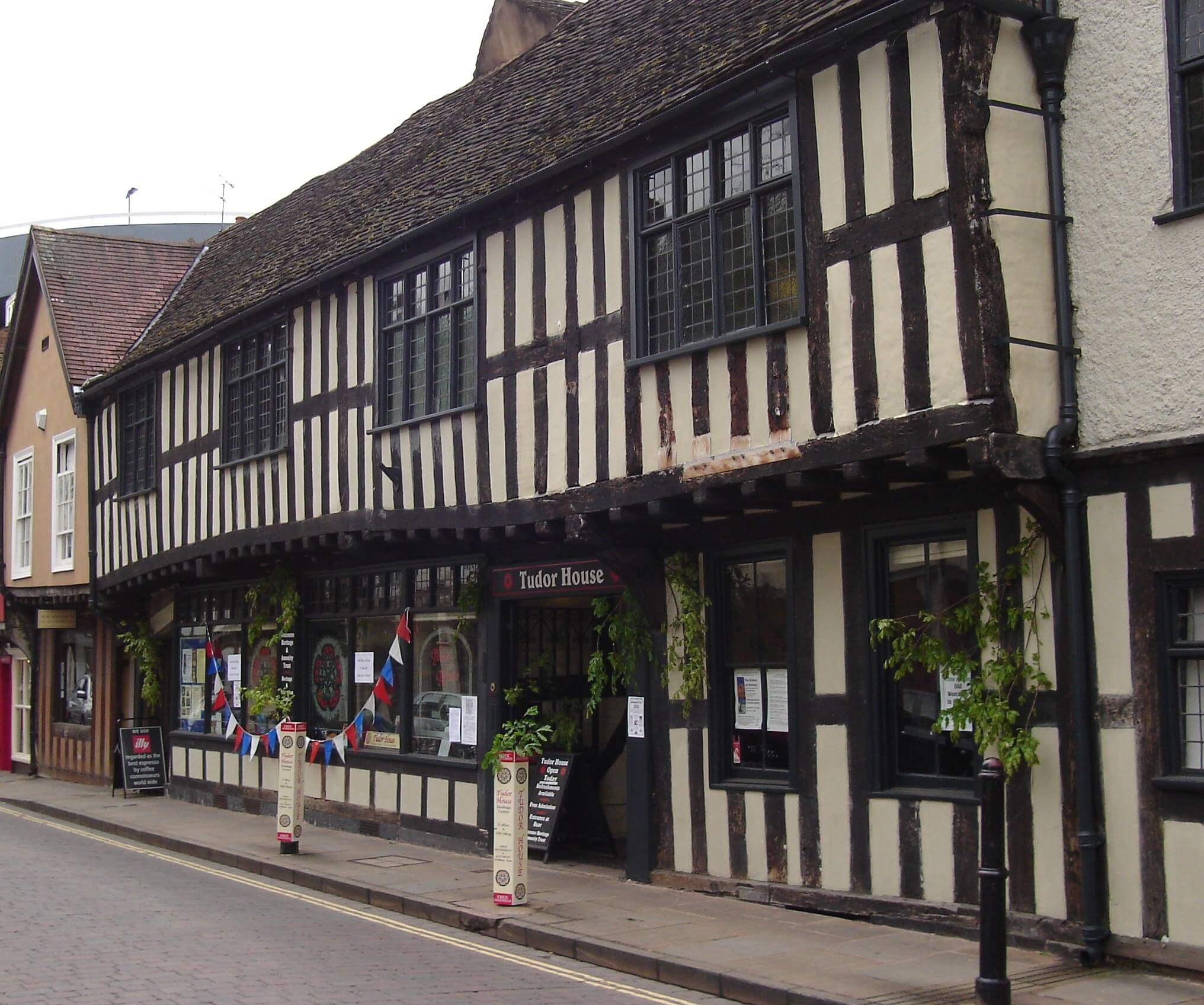Origins
The Company is properly entitled “the Master Wardens and Commonalty of Weavers, Walkers and Clothiers of the City of Worcester."
The Public Orator who addressed Queen Elizabeth, I on the occasion of her visit to Worcester in 1575 recalled that “the inhabitants first began their marte of wooles and their trade of clothyng about the time of "Wolfhere King of Mercia" in the 7th Century, who of his kingly affection towards this towne by his charter granted and made it a citie." The domestic history of Worcester mirrors the country at large throughout the Middle Ages. The development of the Merchant Guilds, their struggle for domination over the Craft Guilds and the evolution of the Merchant Guilds into the City Corporation.
Worcester Guilds
The English guilds were active in the towns long before the Norman Conquest and were less militant than in the more brutalised states of Europe, though flags, banners and armorials of the Worcester Clothiers testify to this latent quality. The guilds of England assiduously developed their position in society using their position and power as a means of enhancing their wealth and influence. Details of the early history of the Company are unclear but it can be presumed they would have been similar to other trade guilds in Worcester and in other towns and cities. When they resurfaced, after the Reformation in the 16th century there were 15 guilds in Worcester. Initially consisting of the Clothiers, Glovers, Cord-Wainers, Bakers, Mercers and Tailors. Later, in the 1600 and 1700s there followed Ironmongers, Butchers, Carpenters, Bricklayers, Coopers, Barbers, Masons, Fishmongers and even Parish Clerks! Today the Clothiers are the last survivor of those fifteen “new” trade guilds.
The Cloth Industry
The cloth trade was incomparably the country's most important export
until the iron and coal era and the trade increased prodigiously after the
Black Death when the labour shortage induced Land-owners to convert arable to
grass-lands and the "White Plague" of sheep covered the country. The
sheep men steadily increased "Enclosure for pasture." The wool was
washed and dried and spun in the country. It was then brought into the towns,
where it was bought, usually at the market, by clothiers. The clothiers
employed persons, usually at their homes, to weave it. After that it passed
through the hands of the Walkers or fullers - who cleansed and felted it (no
doubt using "fullers earth") to close the fibres. After that the
cloth was sent for sale - often to London - and was sold at The Worcester Hall
in Blackwell Hall. The independence of the guilds of weavers in many cities
produced an increasingly better quality and variety of woollen goods and an
increasing demand for English cloth beyond the seas. The processes became
specialised; superior grasses were cultivated, sheep were bred for wool until
England had the best keep for the best sheep. Engineers designed carding-mills
and this branch of the craft became rural as it required water-power. The
wool-farmers, weavers and wool merchants of the west of England increased in
wealth, ingenuity and financial ability.
1522 The Ordinances
An Act of Henry VI, 30th January, 1436, required the craft guilds to have their regulations approved by the chancellor, a chief justice and a judge of assize - "an act for the regulation of mysteries and crafts.” In the reign of Edward IV (1467) and thirty years later in the reign of Henry VII (1497) rules were made for the better maintenance of the clothing trade. It appears that "great cloth making was to be had within the city and suburbs, which employed great part of the people there -spinners, websters, dyers and shearmen. These were no longer to receive their pay in kind, but in gold or silver" - thus anticipating the Truck Acts by some 350 years. It was also decreed that people outside the town were not to be employed in spinning, weaving or cloth-walking "to the hurt of the poor commonalty of the town."
All the wool coming into the city was to be charged with custom, weighed in the Guildhall and sold only there, the Citizens having an hour to make their purchases before any "foreigner" was allowed to buy. It is stated by a historian that in the reign of Henry VIII "the Wealthe of the Towne of Worcester standeth most by drapering, and no towne in England at the present time maketh so many cloaths yerely as this towne doth." In the year 1523, the Fraternity of Weavers of Worcester decided to be law-abiding and they submitted their "Statutes, Acts and Ordinances" to Westminster on a superior, illuminated sheep skin parchment. Their action cannot be ascribed to an excess of virtue. The parchment bears the arms of Aragon or rather the Aragonian pomegranate - a little artlessly since the Great Divorce was germinating and Henry VIII was making eyes at Anne Boleyn. The parchment has an initial capital charmingly illuminated in Madonna blues and gold depicting Our Lady of Worcester sitting at a loom, shuttle in hand, crowned with a nimbus. The ordinances of Henry VII, which repeated older regulations, enjoined that "each Artificer may make cloth for himself, his wife and children and menial servants" without any agreement with the Drapers Craft, provided that if any white or coloured cloth be hurt in coming from the Mill, the Walker may take it and sell it for himself - clearly the Worcester Royal Porcelain Co. Ltd. was not the originator of "seconds." It was also decreed that no article of wool was allowed to be sold by way of trade by any female unless she were a widow as men only were deemed to be competent to negotiate. Every Michaelmas, two persons, one a Weaver and one a Walker, were chosen by the craft to act as searchers and to ascertain that the cloth be "well and workmanly woven and walked." The trade was at that time by far the most important single trade in the City and gave employment to eight thousand people. The Company's Ordinances were confirmated by two Judges of Assize John Fitz James, Chief Baron of the Court of Exchequer and Sir Lewis Pollard Knight.
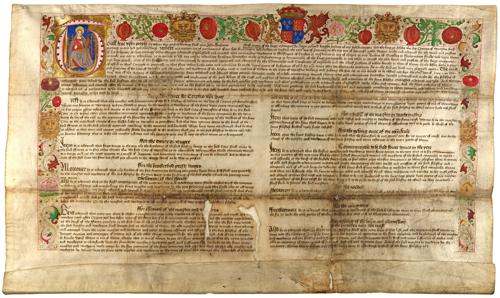


The Ordinances consisted of two large skins of parchment and a third much smaller, all three tied together at the foot. The first sheet is decorated with a fine illuminated border running along the top and both sides, having the royal arms in the centre and a succession of roses, pomegranates and lions heads. Each of these latter bears a crown and holds a weavers shuttle in its teeth. The initial letter includes a female figure seated at a loom. At first it was thought that having a halo it must be a patron saint, but a learned friend referred me to the apocryphal Gospel of James, where it is stated that seven virgins of the tribe of David were chosen to spin the veil of the temple and that "Mary took the true purple and did spin it." This figure then is possibly meant for the Blessed Virgin engaged at her task.
The first ordinance demands that on at 7 o'clock (in the morning) Corpus Christ day, all members congregate at the Friars' house and attend the Cathedral, and anyone unable to do so pays a forfeit in wax.
The second ordinance "Be it ordained that four times in the year all the brethren of the said fellowship being in the said city shall come to the said friars or to some other church within the said City of Worcester as abovesaid when they shall thereunto be warned to a Dirge and the next morning to a mass of Requiem and from thence to a drinking if any be ordained he that is out of the said city shall pay as much to the charge thereof as he that is present"
The quarterly meetings still continue, but the church of the friars is not even a memory. Dirges and Requiem, that is the Office and Mass for deceased members, are no longer celebrated. But the drinking still takes place and absentees still pay forfeit to the funds.
Weaving in all its developing branches of carding, spinning, weaving,
pulling, dyeing; and cloth-finishing produced "Broad-cloth" of
superlative quality under the enthusiastic authority of the Guild. Europe
could not import enough; the Pope himself insisted on English Cotswold cloth up
to recent times. The craft enriched the language when English was rapidly
evolving, with "Spinsters", home spun, tease, web-of-life, unravel,
spin a yarn, fine drawn, Websters, Weavers and Fullers and so on in a way to be
matched in later centuries by the shipping industry. Inevitably the crown
sought counter-balances to this class-privilege and only England secured
domestic peace, security and prosperity by the counter-balancing measures of
class against class with a minimum of civil strife.
1590 The Incorporated Company
On 23rd September 1590 Queen Elizabeth I in a lengthy document beautifully illustrated with a heavy seal granted to the Weavers, Walkers and Clothiers of the City of Worcester a Charter of Incorporation under which it is still governed. This document, bearing the Great Seal of England, appoints "our well beloved Rowland Berkeley, citizen and weaver of the said city" The Master, with the four Wardens (two Weavers and two Walkers) were to be chosen annually on the Friday next after the Feast of Pentecost. There were to be thirty other members, viz 18 weavers, 8 walkers and 4 clothiers, described as: "of the best and most honest citizens, being clothiers, were to be assistants so long as they should behave themselves.
The charter incorporates in one body the three classes of weavers, walkers and clothiers. The stipulation of four Wardens is unusual; most other trade companies have two wardens only. Every member of the trade in the city was entitled to membership of the Company, provided he satisfied the court of assistants that he had served 7 years apprenticeship and was a competent craftsman.
The charter empowered the company to make bye-laws to regulate the trade and gave wide powers of fine and even imprisonment which the magistrates were ordered to enforce. Probably, however, its strongest disciplinary power was that of excluding a member from the company, which deprived him of his livelihood in the city, where no non-members could trade.
The Charter

The Charter of 1590 depicts, not the Queen of Heaven in her humility and splendour, but “our Sovereign Lady Queen Elizabeth I, the virgin Queen, Supreme Govenor of the Church of England as by law established, arrogant and remote”. The Reformation had come and gone.
1575 Queen Elizabeth I Progress to Worcester
In 1575 Queen Elizabeth I visited Worcester and the Weavers subscribed £13.60 towards the cost of the reception and the Walkers contributed a like sum. The Orator who addressed the Queen on behalf of the company related that she should "find the wealth of the City wasted and decayed, the buildings ruined, 360 looms for clothing come to the number of 160 and thereby above 5000 persons that were lately well wrought and relieved, now wanting the same."
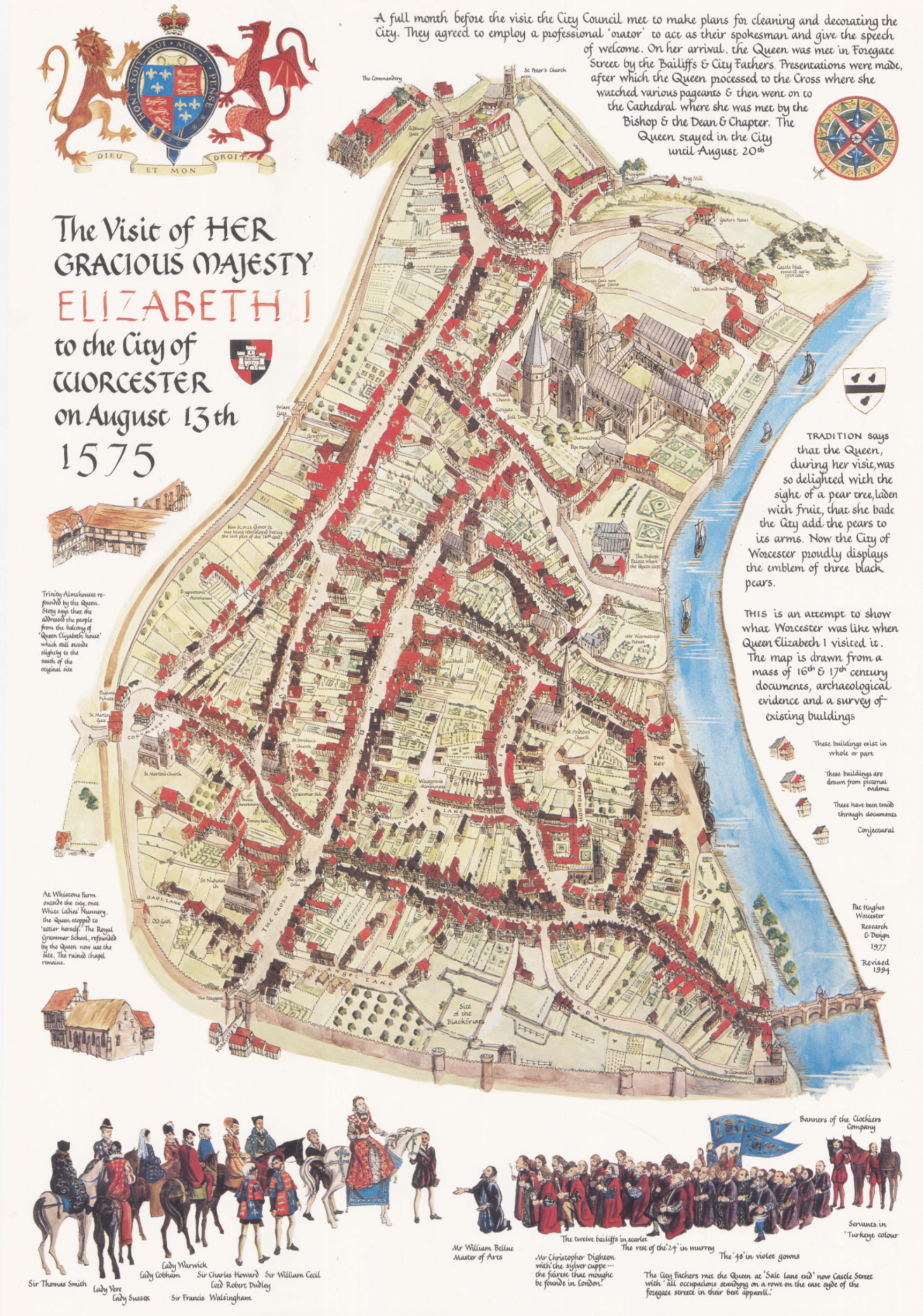
© Pat Hughes
1651 The Royal Debt
In late August 1651 King Charles II arrived at Worcester with his army
of Scots hotly pursued by the Parliamentarian army led by Oliver Cromwell. The
King’s army was in a poor sate after their long march from Scotland. He asked
the Mayor of Worcester to give them new uniforms. The Mayor passed this royal
request to the Clothiers who obliged and presented the king with a bill for
£453 3s. The King said that he would pay the bill once he had defeated
Cromwell. On the 3rd September 1651 Cromwell soundly defeated
Charles II at the Battle of Worcester and King Charles escaped to France. On
the Restoration of the Monarchy in 1660 he did not feel inclined to settle his
account. However, Charles, Prince of Wales agreed to settle the account in 2008
and paid the full amount – with no interest! The purse with which he paid the
royal debt is displayed at meetings of the Company.
The Purse

http://www.worcesternews.co.uk/news/2328471.Prince_to_repay_debt_to_Worcester_company/
1661 Confirmation of the Charter
The Company’s Charter was confirmed by Act of Parliament in 1661, and the trade seems to have flourished until about the end of the 17th century, but by 1711 or thereabouts the trade had fallen upon hard times. Gradually the Company or as they seem to have been two Companies; one of the Weavers and the other of Walkers but combined for many purposes cease to be a trading company, but its continuity remained unbroken, and continues to this day to be governed by the Ordinances of 1522 and the Charter of 1590. The effect of the Ordinances and Charter are now contained the Laws and Regulations and the Customs of the Company, which have been slightly amended from time to time, but they are still based on the original documents. It seems that until 1780 only members of the clothing trade were admitted to be members of the Company, but that after that date members of other trades and professions were admitted. In addition to the Ordinances and the Charter the Company has a number of fascinating treasures:-
1. The seal of the Company, dating from1655, has at one end the arms of the City and at the other the arms of the Company. It bears the name of John Philipps and Anthony Careless - High Wardens 1655.
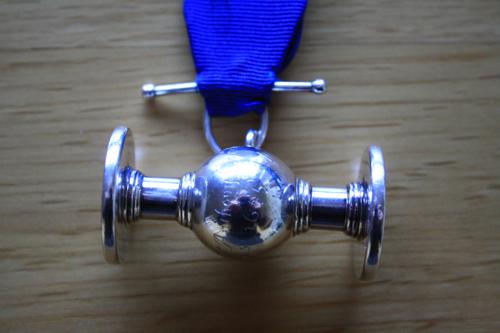
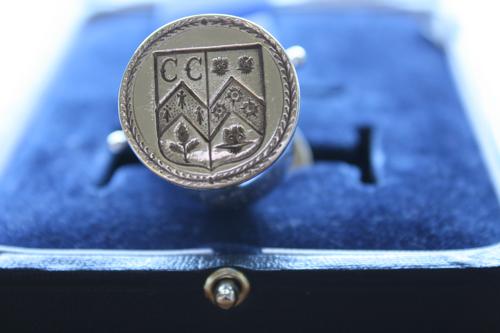
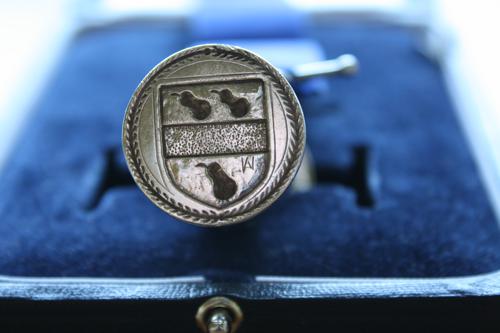
2. The Roll of Members, dating back to 1750, which is signed by every member on joining. It contains the names of many well-known local families.

3. A yard stick - approx. 36 inches long

4. Two C16th shields - one displaying the arms of the Weavers - the other the Cloth Workers.


5. The C16th Banners of the Company, dating from 1540 and which were restored with the assistance of The Worshipful Company of Weavers in 1984, used to be on display in the Commandery until the late 1990s, but are now in safe keeping in the Archives of Museums Worcestershire.
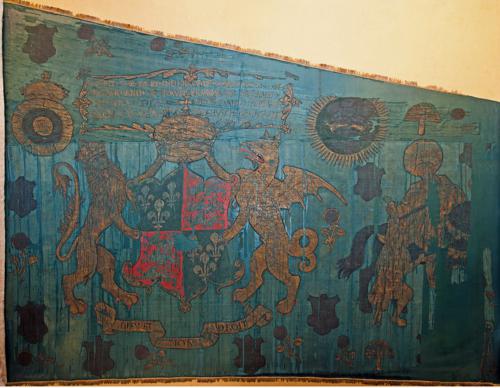
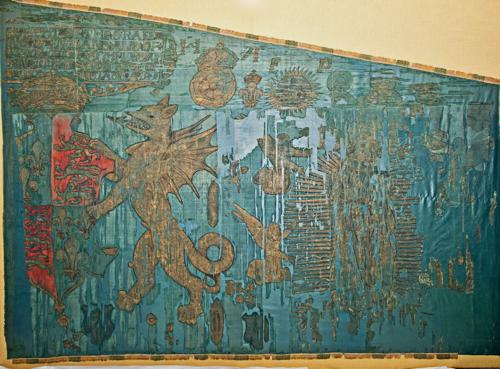
6. The C17th Banners show the Coats of Arms of Queen Elizabeth I and the Clothiers Company.
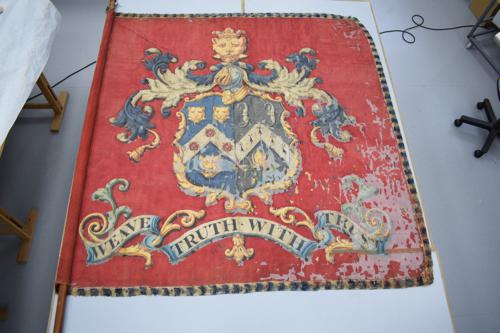
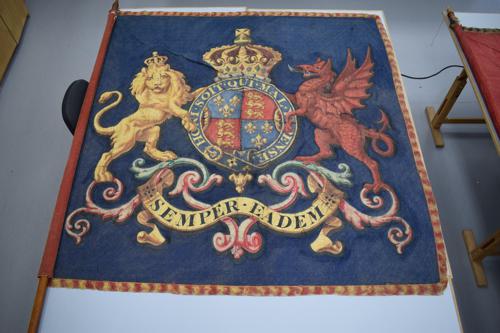
7. The Pall which is thought to have been used at the funeral of Prince Arthur on 25th April 1502 and was at one time used at the funerals of members. It is believed that the Pall originates from the early years of the reign of Henry VII and has also been extensively restored in recent years, once again with the assistance of The Worshipful Company of Weavers. The Pall is on permanent display in the Commandery.
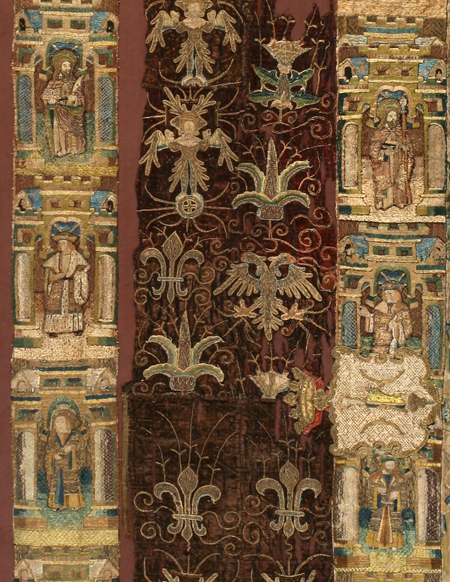
8. The Loving Cup and Secretary’s chalice
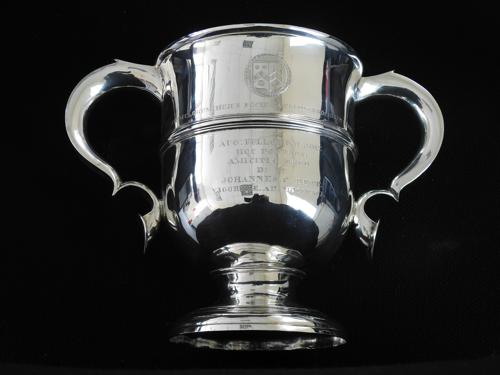
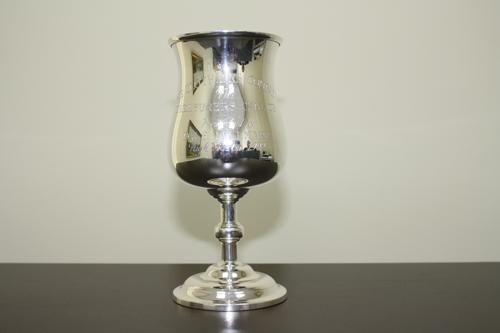
Location
As the old ordinances show, the headquarters of the Company in the Middle Ages was the church of the friars preachers, or Dominicans, in the area called Blackfriars. Under Henry VIII it was suppressed and the buildings sold to the city. So for a time the fraternity of weavers had no home. The religious guild of the Holy Trinity, connected with the parish of St. Nicholas, supported a chantry and school and also possessed a large building called the Trinity Hall. When the guild was suppressed, the Trinity Hall was acquired by speculators and then Robert Yowle, bought it and gave it to the Company. For over 200 years the Trinity Hall was the headquarters of the Clothiers Company and since it was a substantial building containing a number of large rooms, these were let to other companies of which at one time there were at least a dozen in Worcester.
The Hall became used for other purposes, and even the assizes were sometimes held in it. Finally in 1796 the Clothiers sold the building for £185 and it was gradually demolished, the last portion disappearing when Trinity Street was formed.
From 1796 the Clothiers were again homeless. Their meetings were held in various hotels and in recent years in the office of their Treasurer. When the building adjoining "Greyfriars" was being restored to become the Library of the Worcestershire Archaeological Society and funds for that purpose were needed, an arrangement was made between the Clothiers Company and the Archaeological Society. In return for a substantial contribution the Company was granted the right to hold its meetings in the library. So once more the Company had a home, and the money which made that possible was part of the proceeds of the Trinity Hall still remaining after 150 years.
In more recent years the Clothiers have met in the Commandery and now in Tudor House.
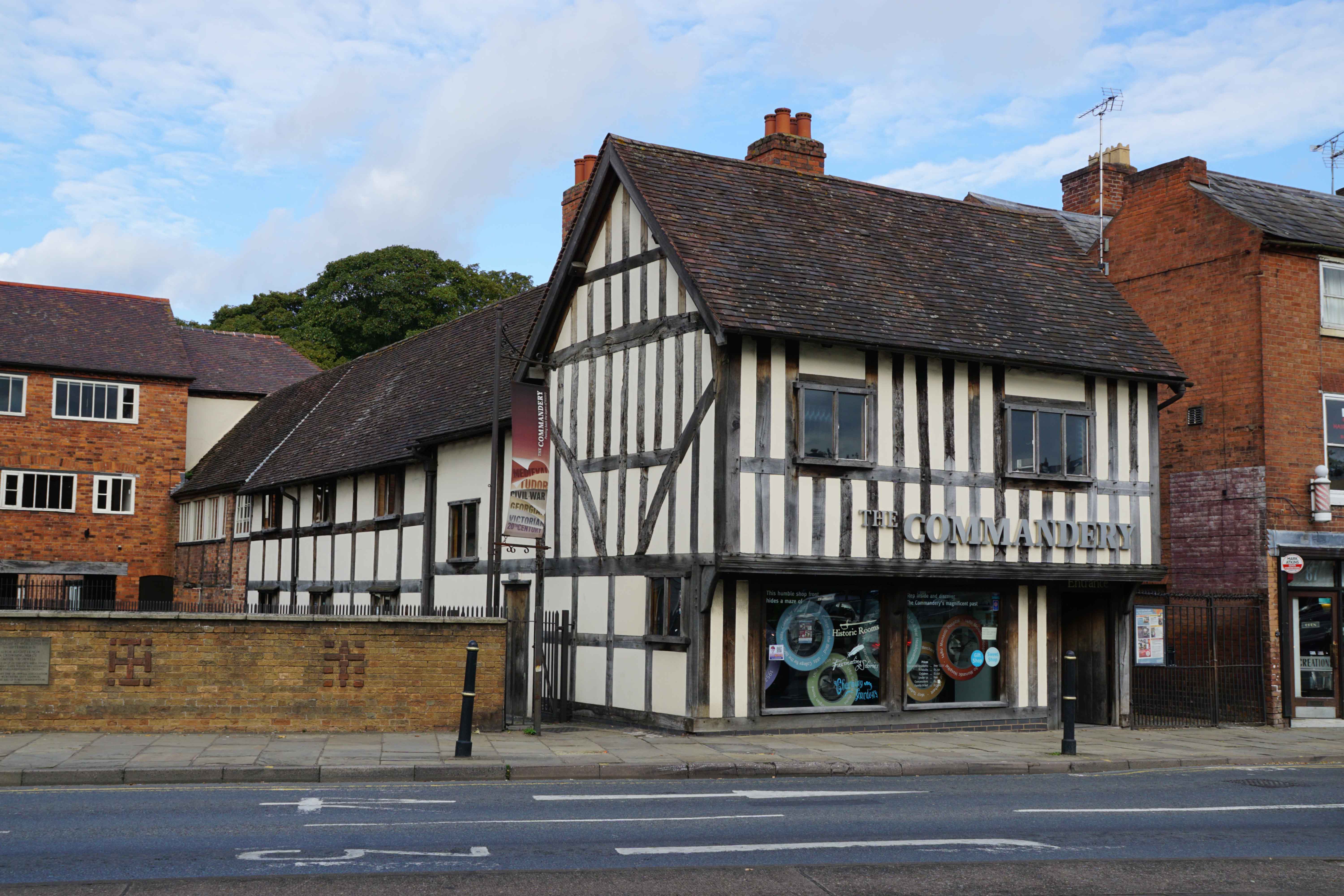
and now in Tudor House.
